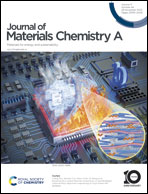Albumin protein encapsulation into a ZIF-8 framework with Co-LDH-based hierarchical architectures for robust catalytic reduction†
Abstract
As a paradigm shift in the field of catalysis, zeolitic imidazolate frameworks (ZIFs) have recently gained significant attention as promising materials given their outstanding catalytic performance and stability in hydrogenation reactions. With their remarkable surface areas and customizable features, ZIFs hint at a future of eco-friendly catalysis. However, the influence of ZIFs' pore structure on their catalysis remains unclear. To overcome this challenge, the present paper proposes how the albumin protein (Pro) can be encapsulated in situ in the ZIF-8 architecture, as well as the design of interface engineering heterojunctions between ZIF-8 and layered double hydroxides (LDHs), resulting in a fresh area of newly synthesized materials far exceeding the performance of the vast majority of catalysts examined thus far. The approach involved the initial mixing of Pro and 2-methylimidazole (2-Mim), followed by the addition of Zn2+ ions. Subsequently, a hierarchical hollow structure coupled with a shell protection strategy was applied to construct three-dimensional (3D) core–shell Pro@ZIF-8-LDH heterostructured nanoflowers that exposed enriched active sites and exhibited strong inter- and intra-molecular interactions. Our results suggest that the incorporation of Pro promotes catalytic activity, provides more active sites, and facilitates the synergistic effects of various interactions. The experimental results demonstrated the remarkable efficiency of the resulting Pro@ZIF-8-LDH catalyst. It exhibited a substantial improvement in reducing 4-nitrophenol to 4-aminophenol, achieving an impressive 97% efficiency. Importantly, this exceptional performance was sustained over 8 consecutive cycles, demonstrating that the incorporation of proteins, alongside the design of interface engineering heterojunctions between ZIF-8 and Co-LDH, not only enhances catalytic performance but also ensures stability over multiple cycles. The effective architectural design proposed in this work, coupled with a deeper understanding of the formation mechanism and interfacial interaction, provides not only a design direction for improving catalytic activity but also opens up new horizons in the construction of other porous materials-derived architectures with promising potential for material science, in the hope of promoting the continued development of this young field.



 Please wait while we load your content...
Please wait while we load your content...